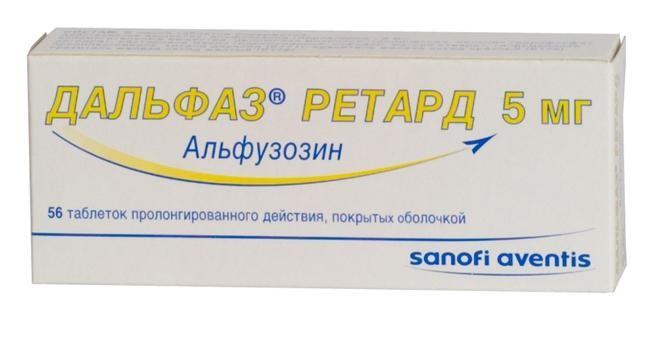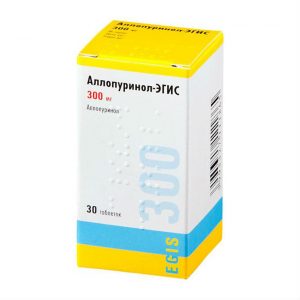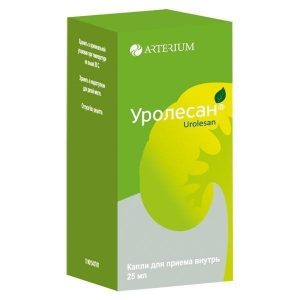Description
Latin name
Dalfaz
Release form
, sustained-release tablets, coated
Packaging
56 pcs
Pharmacological action of
Pharmacodynamics of
Alfuzosin is a quinazoline derivative that is active when administered orally This is a selective antagonist of postsynaptic alpha-1 adrenergic receptors with a peripheral site of action. triangle of the bladder and in the prostatic urethra. As a result of direct exposure to smooth muscles in the tissues of the prostate gland, alpha-1-adrenergic blockers reduce resistance to urine flow. Alfuzosin improves the parameters of excretion, reducing the tone of the urethra and resistance to outflow from the bladder, and facilitates emptying of the bladder. In placebo-controlled trials of alfuzosin in patients with benign prostatic hypertrophy, it was revealed: A significant increase in maximum current velocity (Qmax) by an average of 30% in patients with Qmax 15 ml / sec. This improvement was observed starting with the first dose.
Significant decrease in resistance to urine flow and an increase in the volume of urine excreted, causing the urge to urinate.
Significant decrease in residual urine volume.
Pharmacokinetics:
The maximum plasma concentration is reached approximately 3 hours after ingestion.
The binding of alfuzosin hydrochloride to plasma proteins is about 90%.
The half-life of the drug is 8 hours.
The bioavailability of retard tablets is approximately 15% less than 2, 5 mg alfuzosin. Eating does not affect the absorption of the active substance.
Alfuzosin is metabolized mainly in the liver, only 11% is excreted unchanged in the urine. Most metabolites (which do not have activity) are excreted in feces (75-91%).
In persons older than 75 years, absorption is faster and the maximum concentration and bioavailability are higher. Distribution volume reduced. The elimination half-life does not change
The pharmacokinetic profile of alfuzosin does not change when taking the drug with food.
The volume of distribution and clearance of alfuzosin increased with renal failure, both against the background of dialysis, and without it. There is no need to modify the dosage in patients with impaired renal function and with creatinine clearance> 30 ml / min.
In patients with severe hepatic insufficiency, the elimination half-life is increased.
Bioavailability, in comparison with healthy volunteers, is increased.
The pharmacokinetic profile of alfuzosin does not change in chronic heart failure.
Indications
Treatment of functional symptoms of benign prostatic hyperplasia.
Contraindications
hypersensitivity to alfuzosin and / or other components of the
preparation orthostatic hypotension
severe hepatic impairment (class C according to the Child-Pugh classification)
severe renal impairment (Cl creatinine
due to intestinal obstruction castor oil)
concomitant use of other alpha1-blockers
Caution: patients receiving antihypertensive drugs
elderly patients
patients with indications of hypotension a response to alpha 1-blockers
patients with clinical manifestations of orthostatic hypotension (the possibility of developing orthostatic hypotension)
patients with coronary artery disease, angina pectoris (the possibility of increasing and worsening angina attacks)
patients with symptomatic and asymptomatic manifestations of coronary artery disease (risk of cerebral ischemia with hypotension).
Special instructions
In some individuals, in particular in patients receiving antihypertensive drugs, within a few hours after taking alfuzosin (as well as after taking other alpha1-blockers), orthostatic hypotension may develop with clinical symptoms (dizziness, severe weakness, cold sweat) or without it. Orthostatic hypotension is usually transient and occurs usually at the beginning of the drug and usually does not require discontinuation of treatment. When these phenomena appear, the patient must be in a horizontal position until they completely disappear. Before starting treatment, the patient should be warned about the possibility of such phenomena.
Caution should be exercised when prescribing alfuzosin to patients with orthostatic hypotension with clinical symptoms, patients with a history of a pronounced hypotensive reaction in response to taking other alpha1-blockers need more careful monitoring of blood pressure, including when moving from horizontal to vertical, especially at the beginning of treatment.
Antianginal therapy should continue in patients with coronary artery disease. When resuming or worsening angina, treatment with alfuzosin should be discontinued.
Effect on the ability to drive vehicles and work with mechanisms. Especially at the beginning of treatment, the possibility of developing dizziness and an asthenic state should be taken into account, which may affect the ability to drive vehicles and work with mechanisms.
Composition
1 tablet contains: active substance: alfuzosin hydrochloride 5 mg.
excipients: MCC – 42 mg calcium hydrogen phosphate dihydrate – 65 mg castor oil hydrogenated – 19.6 mg povidone – 7 mg magnesium stearate – 1.4 mg
Dosage and administration
Inside, swallowed whole, washed down with about 1 glass of water, 1 tablet each. (5 mg) 2 times a day (morning and evening).
Adults: the recommended dose is 1 tablet. (5 mg) 2 times a day (morning and evening).
Elderly patients and / or patients with arterial hypertension receiving antihypertensive drugs
As a precaution, when prescribing alfuzosin to these categories of patients, it is recommended to start treatment with 1 table. (5 mg) in the evening, increasing the dose in accordance with the clinical response, but not exceeding the dose – 1 table. 2 times a day.
Patients with renal failure
With a creatinine Cl greater than 30 ml / min, dosage adjustment is not required.
Patients with liver failure
Consideration should be given to the prolongation of T1 / 2 of the drug and the possibility of increasing its bioavailability, therefore treatment should begin with a dose of 2.5 mg once a day, which may increase depending on the clinical response, but should not exceed 2.5 mg 2 times a day.
tablets cannot be crushed, chewed, grind or grind to a powder state, because Violation of the structure of the tablet can lead to accelerated absorption of the active substance, which can contribute to the development of side effects.
Side effects
From the side of the central nervous system and psyche: often – weakness, dizziness, a feeling of general discomfort, headache infrequently – drowsiness, cerebral ischemia (in patients with ischemic brain disease).
From the side of the organs of vision: infrequently – impaired vision.
From the CCC side: often – hypotension (orthostatic) infrequently – tachycardia, palpitations, fainting very rarely – angina pectoris in patients with coronary artery disease, atrial fibrillation.
On the part of the respiratory system: infrequently – rhinitis.
From the gastrointestinal tract: often – nausea, abdominal pain, diarrhea, dry mouth is very rare – damage to hepatocytes, liver disease with cholestasis.
Skin and allergic reactions: infrequently – rash, itching very rarely – urticaria, angioedema.
From the whole organism: often – asthenia infrequently – flushing of the skin, swelling, chest pain is very rare – priapism.
Drug interaction
With the simultaneous use of Dalphase with calcium channel blockers, the risk of developing arterial (including orthostatic) hypotension and collapse increases.
With the simultaneous use of dalphase with agents for general anesthesia, the development of blood pressure instability during anesthesia is likely.
No clinically significant interaction of dalphase with warfarin, digoxin, hydrochlorothiazide, atenolol was noted.
Overdose
Symptoms: arterial hypotension, reflex tachycardia.
Treatment: hospitalization of the patient, constant monitoring of blood pressure. When reducing blood pressure, the introduction of vasoconstrictors and plasma substitutes is recommended (to increase BCC). After the restoration of blood pressure (elimination of hypotension) control over it should be carried out for at least a day.
Hemodialysis is not effective (due to the high degree of binding of alfuzosin to plasma proteins).
Storage Conditions
The product should be stored in a dry, cool place.
Shelf life
3 years.
Deystvuyushtee substance
Alfuzosin
Terms and conditions
Prescription
Dosage form
tablets prolong.
Possible product names
DALFAZ 0.005 N56 TABLE RETARD 0.005 N56 TABLE PROLONG P / O
Dalfaz Retard 5mg Tab. retard tab. n / a 5 mg x 56
Sanofi-Aventis, France




